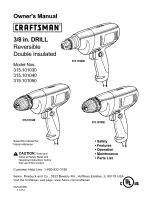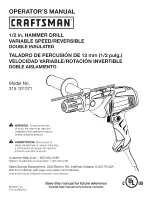
10
Before
lighting
the grill
WARNING: IMPORTANT!
Inspect the gas supply piping or hose prior to
turning the gas on. If there is evidence of cuts,
wear or abrasion, it must be replaced prior to
use. Any replacement pressure regulators or
hose assembly must be the type specified by
the manufacturer.
For LP use, the pressure regulator and hose
assembly supplied with the unit must be used.
This LP tank is equipped with overfill
protection. When you refill or trade in your
tank, make sure the one you receive also has
overfill protection.
If the grill uses LP gas, connect the regulator to
the LP tank and check the hose and regulator
connections for leaks with a soap and water
solution before operating the grill.
Keep a spray bottle of soapy water near the gas
supply valve and check the connections for gas
leaks before each use.
Turn all knobs to OFF then turn on the gas
supply.
Do not use the grill if the odor of gas is present.
Lava rock
(on some models)
The grill is supplied with natural lava rock
(on some models). Because of the porosity of
natural lava rock it is superior in its ability to
capture heat as it rises from the grill burners.
It also possesses the thermal mass needed for
professional results. Flare-ups are controlled
because the lava radiant keeps grease from
getting to the flames and igniting.
The intense heat produced by this system
produces true grilled flavor as fats and juices
are brought to the surface of the food and
caramelized.
Place lava rocks in a single layer on top of the
stainless steel radiant tray located under the
grill rack. It is important to distribute the rocks
evenly over the tray without leaving any large
gaps. Uneven distribution of the rocks and air
gaps can cause localized “hot” and “cold” spots
which could result in unsatisfactory cooking
performance.
Ceramic
briquettes
(on some models)
The intense radiant heat from the ceramic
briquettes caramelizes the fats and juices that
are brought to the surface of the food, giving it
the barbecued flavor.
The ceramic briquettes are in two separate
stainless steel trays located under the grill
racks. The small tray is to be placed in the back
and the large tray is to be placed in the front.
(See the Rotisserie section for placement when
rotisserie cooking.)
Make sure the briquettes are in place in the trays
so that they do not cover the holes in the trays.
AVERTISSEMENT : IMPORTANT!
Inspecter la canalisation d’alimentation de gaz
ou le tuyau avant d’allumer le gaz. S’il existe
un indice de coupure, usure ou abrasion, cette
canalisation doit être remplacée avant
l’utilisation de l’appareil. Tous les régulateurs
de pression ou montage de tuyau de
remplacement doivent être du type spécifié par
le fabricant.
Pour l’utilisation avec le gaz propane, le
régulateur de pression et le montage de tuyau
fournis avec l’appareil doivent être utilisés.
Ce réservoir de gaz propane est muni d’un
dispositif de protection contre le remplissage
excessif. Lorsque vous remplissez de nouveau
ou échangez votre réservoir, s’assurer que celui
que vous recevez a aussi une protection contre
le remplissage excessif.
Si le gril utilise du gaz propane, connecter le
régulateur au réservoir de gaz propane et
vérifier les connexions du tuyau et du
régulateur pour les fuites, avec une solution
de savon et d’eau avant de faire fonctionner
le gril.
Garder une bouteille de vaporisation d’eau
savonneuse près du robinet d’alimentation de
gaz et vérifier les connexions pour les fuites de
gaz avant chaque utilisation.
Tourner tous les boutons à OFF (ARRÊT)
ensuite ouvrir l’approvisionnement de gaz.
Ne pas utiliser le gril s’il existe une odeur
de gaz.
The Grill
Stainless Steel Outdoor Cooking Center











































